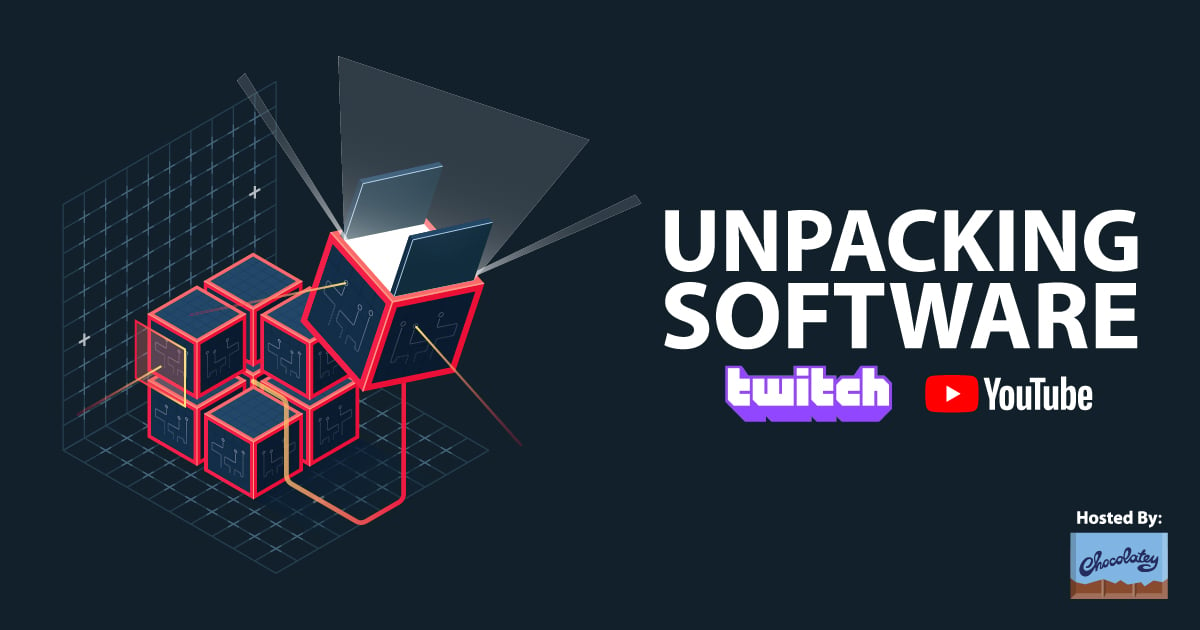
Downloads:
83,180,684
Downloads of v 1.4.0:
48,799,080
Last Update:
19 Apr 2022
Package Maintainer(s):
Software Author(s):
- chocolatey
Tags:
- Software Specific:
- Software Site
- Software Source
- Software License
- Software Docs
- Software Issues
- Package Specific:
- Package outdated?
- Package broken?
- Contact Maintainers
- Contact Site Admins
- Software Vendor?
- Report Abuse
- Download
Chocolatey Core Extensions
- 1
- 2
- 3
1.4.0 | Updated: 19 Apr 2022
- Software Specific:
- Software Site
- Software Source
- Software License
- Software Docs
- Software Issues
- Package Specific:
- Package outdated?
- Package broken?
- Contact Maintainers
- Contact Site Admins
- Software Vendor?
- Report Abuse
- Download
Downloads:
83,180,684
Downloads of v 1.4.0:
48,799,080
Maintainer(s):
Software Author(s):
- chocolatey
Chocolatey Core Extensions 1.4.0
Legal Disclaimer: Neither this package nor Chocolatey Software, Inc. are affiliated with or endorsed by chocolatey. The inclusion of chocolatey trademark(s), if any, upon this webpage is solely to identify chocolatey goods or services and not for commercial purposes.
- 1
- 2
- 3
All Checks are Passing
3 Passing Tests
Deployment Method: Individual Install, Upgrade, & Uninstall
To install Chocolatey Core Extensions, run the following command from the command line or from PowerShell:
To upgrade Chocolatey Core Extensions, run the following command from the command line or from PowerShell:
To uninstall Chocolatey Core Extensions, run the following command from the command line or from PowerShell:
Deployment Method:
This applies to both open source and commercial editions of Chocolatey.
1. Enter Your Internal Repository Url
(this should look similar to https://community.chocolatey.org/api/v2/)
2. Setup Your Environment
1. Ensure you are set for organizational deployment
Please see the organizational deployment guide
2. Get the package into your environment
Option 1: Cached Package (Unreliable, Requires Internet - Same As Community)-
Open Source or Commercial:
- Proxy Repository - Create a proxy nuget repository on Nexus, Artifactory Pro, or a proxy Chocolatey repository on ProGet. Point your upstream to https://community.chocolatey.org/api/v2/. Packages cache on first access automatically. Make sure your choco clients are using your proxy repository as a source and NOT the default community repository. See source command for more information.
- You can also just download the package and push it to a repository Download
-
Open Source
-
Download the package:
Download - Follow manual internalization instructions
-
-
Package Internalizer (C4B)
-
Run: (additional options)
choco download chocolatey-core.extension --internalize --source=https://community.chocolatey.org/api/v2/ -
For package and dependencies run:
choco push --source="'INTERNAL REPO URL'" - Automate package internalization
-
Run: (additional options)
3. Copy Your Script
choco upgrade chocolatey-core.extension -y --source="'INTERNAL REPO URL'" [other options]See options you can pass to upgrade.
See best practices for scripting.
Add this to a PowerShell script or use a Batch script with tools and in places where you are calling directly to Chocolatey. If you are integrating, keep in mind enhanced exit codes.
If you do use a PowerShell script, use the following to ensure bad exit codes are shown as failures:
choco upgrade chocolatey-core.extension -y --source="'INTERNAL REPO URL'"
$exitCode = $LASTEXITCODE
Write-Verbose "Exit code was $exitCode"
$validExitCodes = @(0, 1605, 1614, 1641, 3010)
if ($validExitCodes -contains $exitCode) {
Exit 0
}
Exit $exitCode
- name: Install chocolatey-core.extension
win_chocolatey:
name: chocolatey-core.extension
version: '1.4.0'
source: INTERNAL REPO URL
state: present
See docs at https://docs.ansible.com/ansible/latest/modules/win_chocolatey_module.html.
chocolatey_package 'chocolatey-core.extension' do
action :install
source 'INTERNAL REPO URL'
version '1.4.0'
end
See docs at https://docs.chef.io/resource_chocolatey_package.html.
cChocoPackageInstaller chocolatey-core.extension
{
Name = "chocolatey-core.extension"
Version = "1.4.0"
Source = "INTERNAL REPO URL"
}
Requires cChoco DSC Resource. See docs at https://github.com/chocolatey/cChoco.
package { 'chocolatey-core.extension':
ensure => '1.4.0',
provider => 'chocolatey',
source => 'INTERNAL REPO URL',
}
Requires Puppet Chocolatey Provider module. See docs at https://forge.puppet.com/puppetlabs/chocolatey.
4. If applicable - Chocolatey configuration/installation
See infrastructure management matrix for Chocolatey configuration elements and examples.
This package was approved as a trusted package on 19 Apr 2022.
This is a extension package that provides helper functions installed as a Chocolatey extension.
These functions may be used in Chocolatey install/uninstall scripts by declaring this package a dependency in your package's nuspec.
This package provides helper functions that can be used to enhance what is already available out of the box with Chocolatey CLI.
This includes both features that are being tested for Chocolatey CLI itself, and other helpers to make the maintenance of
Chocolatey packages easier.
Helpers that were available in this package, and were later added to Chocolatey CLI, will be moved to
the package chocolatey-compatibility.extension.
Backwards compatibility is not considered for helpers available in this package, see the Notes below.
Notes
- There is a known bug in the function
Get-AppInstallLocationwith parameter$AppNamePatternwhich is internally used both as wildcard and regex patterns. This usually doesn't create any problems, but may do so if application contains regex symbols in the name, such as notepad++. - This package itself is not concerned with keeping backwards compatibility with Chocolatey CLI. If compatibility is of concern, instead take a dependency on chocolatey-compatibility.extension.
# Export functions that start with capital letter, others are private
# Include file names that start with capital letters, ignore others
$ScriptRoot = Split-Path $MyInvocation.MyCommand.Definition
$pre = Get-ChildItem Function:\*
Get-ChildItem "$ScriptRoot\*.ps1" |
Where-Object { $_.Name -cmatch '^[A-Z]+' } |
ForEach-Object { . $_ }
$post = Get-ChildItem Function:\*
$funcs = Compare-Object $pre $post |
Select-Object -ExpandProperty InputObject |
Select-Object -ExpandProperty Name
$funcs |
Where-Object { $_ -cmatch '^[A-Z]+'} |
ForEach-Object { Export-ModuleMember -Function $_ }<#
.SYNOPSIS
Get application install location
.DESCRIPTION
Function tries to find install location in multiple places. It returns $null if all fail. The following
locations are tried:
- local and machine (x32 & x64) various Uninstall keys
- x32 & x64 Program Files up to the 2nd level of depth
- native commands available via PATH
- locale and machine registry key SOFTWARE\Microsoft\Windows\CurrentVersion\App Paths
Use Verbose parameter to see which of the above locations was used for the result, if any.
.EXAMPLE
PS> Get-AppInstallLocation choco
Returns the install location of the application 'choco'.
.OUTPUTS
[String] or $null
#>
function Get-AppInstallLocation {
[CmdletBinding()]
param(
# Regular expression pattern
[ValidateNotNullOrEmpty()]
[string] $AppNamePattern,
# Allows splatting with arguments that do not apply and future expansion. Do not use directly.
[parameter(ValueFromRemainingArguments = $true)]
[Object[]] $IgnoredArguments
)
function strip($path) { if ($path.EndsWith('\')) { return $path -replace '.$' } else { $path } }
function is_dir( $path ) { $path -and (Get-Item $path -ea 0).PsIsContainer -eq $true }
$ErrorActionPreference = "SilentlyContinue"
Write-Verbose "Trying local and machine (x32 & x64) Uninstall keys"
[array] $key = Get-UninstallRegistryKey $AppNamePattern
if ($key.Count -eq 1) {
Write-Verbose "Trying Uninstall key property 'InstallLocation'"
$location = $key.InstallLocation
if (is_dir $location) { return strip $location }
Write-Verbose "Trying Uninstall key property 'UninstallString'"
$location = $key.UninstallString
if ($location) { $location = $location.Replace('"', '') | Split-Path }
if (is_dir $location) { return strip $location }
Write-Verbose "Trying Uninstall key property 'DisplayIcon'"
$location = $key.DisplayIcon
if ($location) { $location = Split-Path $location }
if (is_dir $location) { return strip $location }
} else { Write-Verbose "Found $($key.Count) keys, aborting this method" }
$dirs = $Env:ProgramFiles, "$Env:ProgramFiles\*\*"
if (Get-OSArchitectureWidth 64) { $dirs += ${ENV:ProgramFiles(x86)}, "${ENV:ProgramFiles(x86)}\*\*" }
Write-Verbose "Trying Program Files with 2 levels depth: $dirs"
$location = (Get-ChildItem $dirs | Where-Object {$_.PsIsContainer}) -match $AppNamePattern | Select-Object -First 1 | ForEach-Object {$_.FullName}
if (is_dir $location) { return strip $location }
Write-Verbose "Trying native commands on PATH"
$location = (Get-Command -CommandType Application) -match $AppNamePattern | Select-Object -First 1 | ForEach-Object { Split-Path $_.Source }
if (is_dir $location) { return strip $location }
$appPaths = "\SOFTWARE\Microsoft\Windows\CurrentVersion\App Paths"
Write-Verbose "Trying Registry: $appPaths"
$location = (Get-ChildItem "HKCU:\$appPaths", "HKLM:\$appPaths") -match $AppNamePattern | Select-Object -First 1
if ($location) { $location = Split-Path $location }
if (is_dir $location) { return strip $location }
Write-Verbose "No location found"
}
<#
.SYNOPSIS
Get a 'free' drive letter
.DESCRIPTION
Get a not yet in-use drive letter that can be used for mounting
.EXAMPLE
Get-AvailableDriveLetter
.EXAMPLE
Get-AvailableDriveLetter 'X'
(do not return X, even if it'd be the next choice)
.INPUTS
specific drive letter(s) that will be excluded as potential candidates
.OUTPUTS
System.String (single drive-letter character)
.LINK
http://stackoverflow.com/questions/12488030/getting-a-free-drive-letter/29373301#29373301
#>
function Get-AvailableDriveLetter {
param (
[char[]]$ExcludedLetters,
# Allows splatting with arguments that do not apply and future expansion. Do not use directly.
[parameter(ValueFromRemainingArguments = $true)]
[Object[]] $IgnoredArguments
)
$Letter = [int][char]'C'
$i = @()
#getting all the used Drive letters reported by the Operating System
$(Get-PSDrive -PSProvider filesystem) | ForEach-Object{$i += $_.name}
#Adding the excluded letter
$i+=$ExcludedLetters
while($i -contains $([char]$Letter)){$Letter++}
if ($Letter -gt [char]'Z') {
throw "error: no drive letter available!"
}
Write-Verbose "available drive letter: '$([char]$Letter)'"
Return $([char]$Letter)
}
<#
.SYNOPSIS
Get the current proxy using several methods
.DESCRIPTION
Function tries to find the current proxy using several methods, in the given order:
- $env:chocolateyProxyLocation variable
- $env:http_proxy environment variable
- IE proxy
- Chocolatey config
- Winhttp proxy
- WebClient proxy
Use Verbose parameter to see which of the above locations was used for the result, if any.
The function currently doesn't handle the proxy username and password.
.OUTPUTS
[String] in the form of http://<proxy>:<port>
#>
function Get-EffectiveProxy(){
# Try chocolatey proxy environment vars
if ($env:chocolateyProxyLocation) {
Write-Verbose "Using `$Env:chocolateyProxyLocation"
return $env:chocolateyProxyLocation
}
# Try standard Linux variable
if ($env:http_proxy) {
Write-Verbose "Using `$Env:http_proxy"
return $env:http_proxy
}
# Try to get IE proxy
$key = "HKCU:\Software\Microsoft\Windows\CurrentVersion\Internet Settings"
$r = Get-ItemProperty $key
if ($r.ProxyEnable -and $r.ProxyServer) {
Write-Verbose "Using IE proxy settings"
return "http://" + $r.ProxyServer
}
# Try chocolatey config file
[xml] $cfg = Get-Content $env:ChocolateyInstall\config\chocolatey.config
$p = $cfg.chocolatey.config | ForEach-Object { $_.add } | Where-Object { $_.key -eq 'proxy' } | Select-Object -Expand value
if ($p) {
Write-Verbose "Using choco config proxy"
return $p
}
# Try winhttp proxy
(netsh.exe winhttp show proxy) -match 'Proxy Server\(s\)' | Set-Variable proxy
$proxy = $proxy -split ' :' | Select-Object -Last 1
$proxy = $proxy.Trim()
if ($proxy) {
Write-Verbose "Using winhttp proxy server"
return "http://" + $proxy
}
# Try using WebClient
$url = "http://chocolatey.org"
$client = New-Object System.Net.WebClient
if ($client.Proxy.IsBypassed($url)) { return $null }
Write-Verbose "Using WebClient proxy"
return "http://" + $client.Proxy.GetProxy($url).Authority
}
<#
.SYNOPSIS
Get temporary location for the package based on its name and version.
.DESCRIPTION
The function returns package cache directory within $Env:TEMP. It will not create the directory
if it doesn't exist.
This function is useful when you have to obtain the file using `Get-ChocolateyWebFile` in order
to perform certain installation steps that other helpers can't do.
.EXAMPLE
Get-PackageCacheLocation
.OUTPUTS
[String]
.LINKS
Get-ChocolateyWebFile
#>
function Get-PackageCacheLocation {
[CmdletBinding()]
param (
# Name of the package, by default $Env:ChocolateyPackageName
[string] $Name = $Env:ChocolateyPackageName,
# Version of the package, by default $Env:ChocolateyPackageVersion
[string] $Version = $Env:ChocolateyPackageVersion,
# Allows splatting with arguments that do not apply and future expansion. Do not use directly.
[parameter(ValueFromRemainingArguments = $true)]
[Object[]] $IgnoredArguments
)
if (!$Name) { Write-Warning 'Environment variable $Env:ChocolateyPackageName is not set' }
$res = Join-Path $Env:TEMP $Name
if (!$Version) { Write-Warning 'Environment variable $Env:ChocolateyPackageVersion is not set' }
$res = Join-Path $res $Version
$res
}
<#
.SYNOPSIS
Download file with choco internals
.DESCRIPTION
This function will download a file from specified url and return it as a string.
This command should be a replacement for ubiquitous WebClient in install scripts.
The benefit of using this command instead of WebClient is that it correctly handles
system or explicit proxy.
.EXAMPLE
PS C:\> $s = Get-WebContent "http://example.com"
PS C:\> $s -match 'Example Domain'
True
First command downloads html content from http://example.com and stores it in $s.
Now you can parse and match it as a string.
.EXAMPLE
PS C:\> $opts = @{ Headers = @{ Referer = 'http://google.com' } }
PS C:\> $s = Get-WebContent -url "http://example.com" -options $opts
You can set headers for http request this way.
.INPUTS
None
.OUTPUTS
System.String
.NOTES
This function can only return string content.
If you want to download a binary content, please use Get-WebFile.
.LINK
Get-WebFile
#>
function Get-WebContent {
[CmdletBinding()]
param(
# Url to download
[string]$Url,
# Additional options for http request.For now only Headers property supported.
[hashtable]$Options,
# Allows splatting with arguments that do not apply and future expansion. Do not use directly.
[parameter(ValueFromRemainingArguments = $true)]
[Object[]] $IgnoredArguments
)
$filePath = get_temp_filepath
Get-WebFile -Url $Url -FileName $filePath -Options $Options 3>$null
$fileContent = Get-Content $filePath -ReadCount 0 | Out-String
Remove-Item $filePath
$fileContent
}
function get_temp_filepath() {
$tempDir = Get-PackageCacheLocation
$fileName = [System.IO.Path]::GetRandomFileName()
Join-Path $tempDir $fileName
}
<#
.SYNOPSIS
Register application in the system
.DESCRIPTION
The function will register application in the system using App Paths registry key so that you
can start it by typing its registred name in the Windows Start menu on using run dialog (Win + R).
To make applications available in the shell, add to your profile Set-AppKeyAliases function.
.EXAMPLE
Register-Application 'c:\windows\notepad.exe'
Register application using name derived from its file name.
.EXAMPLE
Register-Application 'c:\windows\notepad.exe' -Name ntp
Register application using explicit name.
.LINK
Set-AppKeyAliases - https://github.com/majkinetor/posh/blob/master/MM_Admin/Set-AppKeyAliases.ps1
Application Registration - https://msdn.microsoft.com/en-us/library/windows/desktop/ee872121(v=vs.85).aspx
#>
function Register-Application{
[CmdletBinding()]
param(
# Full path of the executable to register.
[Parameter(Mandatory=$true)]
[string]$ExePath,
# Optional name to register with. By default exe name will be used.
[string]$Name,
# Register application only for the current user. By default registration is for the machine.
[switch]$User,
# Allows splatting with arguments that do not apply and future expansion. Do not use directly.
[parameter(ValueFromRemainingArguments = $true)]
[Object[]] $IgnoredArguments
)
if (!(Test-Path $ExePath)) { throw "Path doesn't exist: $ExePath" }
if (!$Name) { $Name = Split-Path $ExePath -Leaf } else { $Name = $Name + '.exe' }
$appPathKey = "HKLM:\SOFTWARE\Microsoft\Windows\CurrentVersion\App Paths\$Name"
if ($User) { $appPathKey = "HKCU:\SOFTWARE\Microsoft\Windows\CurrentVersion\App Paths\$Name" }
If (!(Test-Path $AppPathKey)) { New-Item "$AppPathKey" | Out-Null }
Set-ItemProperty -Path $AppPathKey -Name "(Default)" -Value $ExePath
}
<#
.SYNOPSIS
Ensure that process is stopped in reliable way
.DESCRIPTION
Close the processes matching filters gracefully first, then forcefully.
If no process is found, function will simply do and return nothing.
.EXAMPLE
notepad; Remove-Process notepad -PathFilter 'system32'
Close main window of notepad that has 'system32' word in its path
.EXAMPLE
Remove-Process notepad -WaitFor 30
notepad; notepad #in another shell
Close all instances of notepad but wait for them up to 30 seconds to start
.OUTPUTS
Array of closeed processes with details about each one.
.NOTES
https://github.com/chocolatey-community/chocolatey-coreteampackages/issues/1364
#>
function Remove-Process {
param(
# RegEx expression of process name, returned by Get-Process function
[string] $NameFilter,
# RegEx expression of process path, returned by Get-Process function
[string] $PathFilter,
# Wait for process to start number of seconds
# Function will try to find process every second until timeout.
[int] $WaitFor,
# Close/Kill child processes, by default they are filtered out as
# parent-child relationship usually have its own heartbeat feature
[switch] $WithChildren
)
function getp {
foreach ($p in Get-Process) {
$b1 = if ($NameFilter) { $p.ProcessName -match $NameFilter }
$b2 = if ($PathFilter) { $p.Path -match $PathFilter }
$b = if (($b1 -ne $null) -and ($b2 -ne $null)) { $b1 -and $b2 } else { $b1 -or $b2 }
if (!$b) { continue }
$w = Get-WmiObject win32_process -Filter "ProcessId = $($p.Id)"
[PSCustomObject]@{
Id = $p.Id
ParentId = $w.ParentProcessId
Name = $p.ProcessName
Path = $p.Path
CommandLine = $w.CommandLine
Process = $p
Username = $w.GetOwner().Domain + "\"+ $w.GetOwner().User
}
}
}
$proc = getp
if (!$proc -and $WaitFor) {
Write-Verbose "Waiting for process up to $WaitFor seconds"
for ($i=0; $i -lt $WaitFor; $i++) { Start-Sleep 1; $proc = getp; if ($proc) {break} }
}
if (!$proc) { return }
# Process might spawn multiple children, typical for browsers; remove all children as parent will handle them
if (!$WithChildren) {
Write-Verbose "Remove all children processes"
$proc = $proc | Where-Object { $proc.Id -notcontains $_.ParentId }
}
foreach ($p in $proc) {
Write-Verbose "Trying to close app '$($p.Name)' run by user '$($p.Username)'"
if ( $p.Process.CloseMainWindow() ) {
# wait for app to shut down for some time, max 5s
for ($i=0; $i -lt 5; $i++) {
Start-Sleep 1
$p2 = Get-Process -PID $p.id -ea 0
if (!$p2) { break }
}
}
# Return value of CloseMainWindow() 'True' is not reliable
# so if process is still active kill it
$p2 = Get-Process -PID $p.id -ea 0
if (($p.Process.Name -eq $p2.Name) -and ($p.Process.StartTime -eq $p2.StartTime)) {
$p | Stop-Process -ea STOP
Start-Sleep 1 # Running to fast here still gets the killed process in next line
}
$p2 = Get-Process -PID $p.id -ea 0
if (($p.Process.Name -eq $p2.Name) -and ($p.Process.StartTime -eq $p2.StartTime)) {
Write-Warning "Process '$($p.Name)' run by user '$($p.Username)' can't be closed"
}
}
$proc
}
Log in or click on link to see number of positives.
In cases where actual malware is found, the packages are subject to removal. Software sometimes has false positives. Moderators do not necessarily validate the safety of the underlying software, only that a package retrieves software from the official distribution point and/or validate embedded software against official distribution point (where distribution rights allow redistribution).
Chocolatey Pro provides runtime protection from possible malware.
| Add to Builder | Version | Downloads | Last Updated | Status |
|---|---|---|---|---|
| Chocolatey Core Extensions 1.4.0 | 48799080 | Tuesday, April 19, 2022 | Approved | |
| Chocolatey Core Extensions 1.3.5.1 | 20495633 | Thursday, November 21, 2019 | Approved | |
| Chocolatey Core Extensions 1.3.5 | 258969 | Thursday, November 14, 2019 | Approved | |
| Chocolatey Core Extensions 1.3.4 | 461863 | Wednesday, October 30, 2019 | Approved | |
| Chocolatey Core Extensions 1.3.3 | 9529175 | Wednesday, October 11, 2017 | Approved | |
| Chocolatey Core Extensions 1.3.2 | 19114 | Tuesday, October 10, 2017 | Approved | |
| Chocolatey Core Extensions 1.3.1 | 1513563 | Tuesday, May 23, 2017 | Approved | |
| Chocolatey Core Extensions 1.3.0 | 326640 | Friday, April 21, 2017 | Approved | |
| Chocolatey Core Extensions 1.2.0 | 380721 | Monday, March 20, 2017 | Approved | |
| Chocolatey Core Extensions 1.1.0 | 229914 | Thursday, February 23, 2017 | Approved | |
| Chocolatey Core Extensions 1.0.7 | 200240 | Monday, February 13, 2017 | Approved | |
| Chocolatey Core Extensions 1.0.6 | 111951 | Wednesday, February 1, 2017 | Approved | |
| Chocolatey Core Extensions 1.0.5 | 86647 | Tuesday, January 24, 2017 | Approved | |
| Chocolatey Core Extensions 1.0.4 | 329620 | Monday, December 12, 2016 | Approved | |
| Chocolatey Core Extensions 1.0.3 | 61548 | Friday, December 9, 2016 | Approved | |
| Chocolatey Core Extensions 1.0.2 | 35685 | Wednesday, December 7, 2016 | Approved | |
| Chocolatey Core Extensions 1.0.1 | 46017 | Friday, December 2, 2016 | Approved | |
| Chocolatey Core Extensions 1.0 | 143721 | Sunday, November 13, 2016 | Approved | |
| Chocolatey Core Extensions 0.1.3 | 130412 | Monday, October 24, 2016 | Approved | |
| Chocolatey Core Extensions 0.1.2 | 18342 | Sunday, October 23, 2016 | Approved | |
| Chocolatey Core Extensions 0.1.1 | 852 | Sunday, October 23, 2016 | Approved | |
| Chocolatey Core Extensions 0.1.0 | 977 | Saturday, October 22, 2016 | Approved |
© 2016 Chocolatey Core Team Package Contributors
1.4.0
- Bugfix: Expand all aliases used in helper scripts (#8)
- Add dependency of compatibility packages to prevent breaking changes (#7)
- Remove
Get-PackageParametersandGet-UninstallRegistryKeythat are moved to chocolatey-compatibility.extension package instead (#6)
1.3.5
- Bugfix
Remove-Process: Fixed Powershell v2 compatibility issue
1.3.4
- Added
Remove-Processfunction to ensure that process is stopped in reliable way
1.3.3
- Bugfix
Get-AppInstallLocation: fix path is directory
1.3.2
- Bugfix
Get-AppInstallLocation: now checks if path is directory
1.3.1
- Bugfix in
Get-AppInstallLocation: Removed extra$locationparameter from Split-Path when parsing the registry UninstallString.
1.3.0
Get-EffectiveProxy: Get the current proxy using several methods
1.2.0
- Use
$IgnoredArgumentsin all functions to allow for future expansion and splatting (#621) - Bugfix in
Get-PackageParametersparsing of paths containing symbol chars.
1.1.0
Get-AvailableDriveLetter: Get the next unused drive letter
1.0.7
- Bugfix in
Get-PackageParameters: flags can now have numbers in their names, whereas before, everything past the number would be truncated and the flag would turn into a boolean.
1.0.6
- Bugfix in
Get-AppInstallLocation: Powershell 2 can not replace on null value.
1.0.5
- Bugfix in
Get-UninstallRegistryKey: Powershell 2 compatibility. - Slightly improved documentation of
Get-UninstallRegistryKey.
1.0.4
- Bugfix in
Get-PackageParameters: Powershell 2 bug workaround (#465).
1.0.3
- Bugfix in
Get-PackageParameters: error when parsing of path.
1.0.2
- Bugfix in
Get-PackageParameters: PowerShell 2 compatibility.
1.0.1
- Bugfix in
Get-PackageParameters: unaliasedslsto work on PowerShell 2.
1.0
- Merged
mm-choco.extension. - Merged
chocolatey-uninstall.extension. - Added
Get-PackageCacheLocation - Added
CHANGELOG.mdandREADME.md. - Refactoring and more documentation.
0.1.3
Get-WebContent: Download file with choco internals.
Ground Rules:
- This discussion is only about Chocolatey Core Extensions and the Chocolatey Core Extensions package. If you have feedback for Chocolatey, please contact the Google Group.
- This discussion will carry over multiple versions. If you have a comment about a particular version, please note that in your comments.
- The maintainers of this Chocolatey Package will be notified about new comments that are posted to this Disqus thread, however, it is NOT a guarantee that you will get a response. If you do not hear back from the maintainers after posting a message below, please follow up by using the link on the left side of this page or follow this link to contact maintainers. If you still hear nothing back, please follow the package triage process.
- Tell us what you love about the package or Chocolatey Core Extensions, or tell us what needs improvement.
- Share your experiences with the package, or extra configuration or gotchas that you've found.
- If you use a url, the comment will be flagged for moderation until you've been whitelisted. Disqus moderated comments are approved on a weekly schedule if not sooner. It could take between 1-5 days for your comment to show up.









 Ansible
Ansible

 PS DSC
PS DSC
